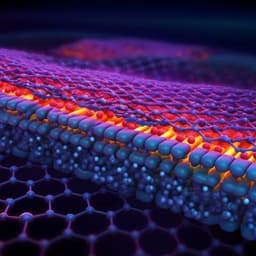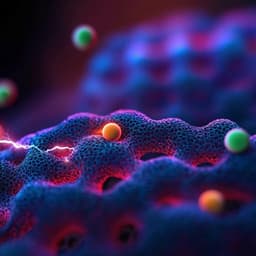Introduction
Porous membranes crafted from two-dimensional (2D) materials hold immense promise for separation technologies due to their atomic-scale thickness, which theoretically enables significantly faster molecular permeation compared to conventional 3D membranes. The permeation rate in 2D membranes is not inversely proportional to thickness, unlike 3D membranes. Research has focused on 2D membranes with relatively large pores (effective size *d*<sub>o</sub> larger than the kinetic diameter *d*<sub>e</sub> of the molecules), a regime well-described by Knudsen diffusion theory. This allows for moderate selectivity based on the thermal velocities of gases with different molecular weights *m*. However, significantly improved selectivity can be achieved with angstrom-scale pores (*d*<sub>o</sub> ≈ *d*<sub>e</sub>), where molecules face substantial activation barriers for passage, leading to exponential selectivity enhancement. The trade-off between permeability and selectivity remains a challenge, motivating the search for new materials. Nanopores in 2D crystals are often created through top-down fabrication methods that introduce nanoscale defects, while bottom-up synthesis of nanoporous membranes (like laminates of 2D materials or multilayer films of intrinsically porous crystals) is another promising approach. The gas permeation mechanisms in these quasi-2D membranes, especially experimentally, are still not fully understood and may deviate from simple Knudsen and activated transport models. Graphdiyne, a carbon allotrope with intrinsic triangular pores of a few angstroms, is a potential candidate for high-performance molecular-sieving membranes. While theoretical and simulation studies have explored its potential, experimental validation of its gas separation properties has been lacking. This study investigates gas transport through graphdiyne-based nanoporous films to experimentally evaluate their gas separation capabilities and unravel the underlying transport mechanisms.
Literature Review
Existing literature extensively explores the potential of two-dimensional (2D) materials for creating highly permeable and selective gas separation membranes. Studies on atomically thin porous graphene demonstrate ultra-fast permeation, highlighting the potential of 2D materials. However, achieving both high permeability and selectivity remains a significant challenge, often requiring a trade-off between the two properties. Angstrom-scale pores show promise for high selectivity due to significant activation barriers for molecular transport; however, this comes at the cost of reduced permeability. Various fabrication techniques, including top-down approaches for creating defects in initially impermeable 2D materials and bottom-up synthesis methods like creating laminates or multilayer films, have been investigated for creating nanoporous 2D membranes. Graphdiyne, a novel carbon allotrope with intrinsic porosity, has been theoretically predicted to exhibit high selectivity and permeability for gas separation, but experimental verification was needed. This work addresses this gap by focusing on the experimental characterization of gas permeation through graphdiyne-based membranes.
Methodology
Graphdiyne-based nanoporous films were synthesized via coupling reactions of hexaethynylbenzene molecules. The synthesis involved the coupling of 1,2,3,4,5,6-hexaethynylbenzene (HEB) on treated copper foils under specific reaction conditions (argon atmosphere, 110°C) for 64 hours. The resulting films were characterized using Raman and X-ray photoelectron spectroscopy (details in Supplementary Information). Scanning electron microscopy (SEM) and transmission electron microscopy (TEM) were used for morphological characterization. SEM imaging, including cross-sectional views obtained via focused ion beam (FIB) milling, revealed a complex morphology comprising a ~90 nm thick quasi-2D layer of multilayer graphdiyne crystallites and a scaffold-like structure of interconnected nanometer-thick vertical walls or merged microwells. TEM analysis confirmed the ABC-stacked graphdiyne structure. For gas permeation studies, graphdiyne films were suspended over micrometer-sized apertures etched in silicon nitride/silicon wafers. These devices were placed between two vacuum-tight chambers; one chamber contained the test gas(es), while the other was under high vacuum and connected to a mass spectrometer. Permeation measurements were conducted using various gases (He, ³He, Ne, Ar, Kr, Xe, D₂, HD) at room temperature and at cryogenic temperatures down to 10 K (He) and 30 K (H₂). The gas flow rate was measured as a function of applied pressure. Binary gas mixtures were also used to study the effects of interactions between gases during permeation. The temperature dependence of gas permeance provided information on the pore size distribution. Control experiments were performed using bare apertures and graphene-covered apertures to estimate the porosity of the graphdiyne films.
Key Findings
The graphdiyne-based membranes, despite their ~90 nm thickness, exhibited fast, Knudsen-type permeation of light gases (He, H isotopes, Ne) but significantly suppressed flow rates for heavier noble gases (Kr, Xe). The observed permeance for light gases followed the Knudsen dependence (I ∝ m⁻¹/²), indicating free molecular flow. However, heavy gases showed deviations from this behavior. Cryogenic temperature measurements (down to 10 K for He and 30 K for H₂) revealed that permeance varied as ∝ T⁻¹/², consistent with Knudsen flow. This allowed the estimation of pore sizes as 1 nm < *d*<sub>o</sub> < 5 nm. The membranes exhibited a porosity of ~0.1%, significantly higher than other 2D membranes reported previously. Crucially, experiments with binary gas mixtures revealed nonlinear flow behavior. The permeance of He was significantly suppressed in the presence of heavier noble gases, indicating adsorption of heavier atoms on the pore walls reduces effective pore size and thus flow rate. The interaction between gas flows in mixtures is attributed to adsorption of heavy gases on the pore interior, which reduces the effective pore size and thus the permeation rate. This effect decreases with lighter noble gases, correlating with reduced adsorption energy. The observed selectivity between He and Xe was ~20, significantly higher than that expected from Knudsen flow alone.
Discussion
The findings challenge the typical understanding of gas transport through nanoporous membranes. While the Knudsen diffusion model accurately predicts the behavior of light gases, the significant suppression of heavy gas permeance necessitates considering adsorption effects. The high porosity of the graphdiyne membranes, coupled with the relatively small pore sizes, creates an environment where adsorption of heavier atoms on the pore walls plays a dominant role. This contrasts with the behavior observed in other 2D systems where adsorbed molecules can exhibit in-plane mobility, potentially enhancing permeation. The interaction effects observed in binary mixtures highlight the complexity of transport at the nanoscale, demonstrating that even seemingly inert gases can exhibit coupled flow behavior due to adsorption. These observations provide valuable insights into gas transport mechanisms in quasi-2D nanoporous materials, which could lead to the development of advanced gas separation technologies.
Conclusion
This study experimentally demonstrated fast and selective gas permeation through quasi-2D graphdiyne-based nanoporous membranes. The observed high permeance for light gases and the significant selectivity enhancement for heavier gases were explained by considering the interplay between Knudsen diffusion and adsorption effects. The unusual interaction between gas flows in mixtures highlights the importance of adsorption phenomena in nanoscale transport. These findings provide valuable insights into gas permeation at the nanoscale and pave the way for the design of advanced gas separation technologies with improved efficiency. Future work could explore the impact of different graphdiyne structures and pore size distributions on gas transport properties and explore potential applications in various separation processes.
Limitations
The precise determination of pore size and morphology remains a limitation of this study. TEM imaging was challenging due to the instability of the thinnest regions under electron beam exposure. Further, the study focused on a limited range of gases and pressures. A more comprehensive investigation using a wider range of gases and pressures, as well as advanced characterization techniques, could provide a more complete understanding of the gas transport mechanisms. Additionally, the long-term stability of the membranes under operating conditions needs further evaluation for practical applications.
Related Publications
Explore these studies to deepen your understanding of the subject.







